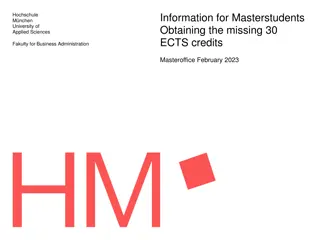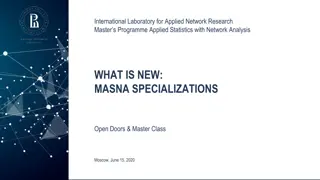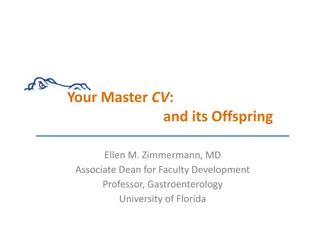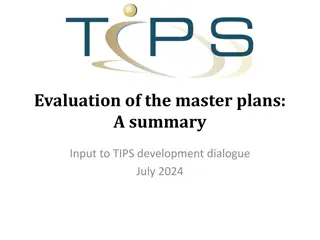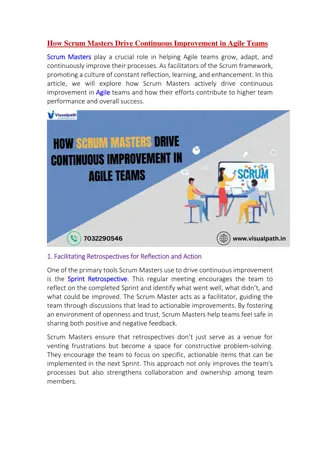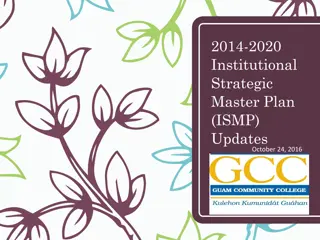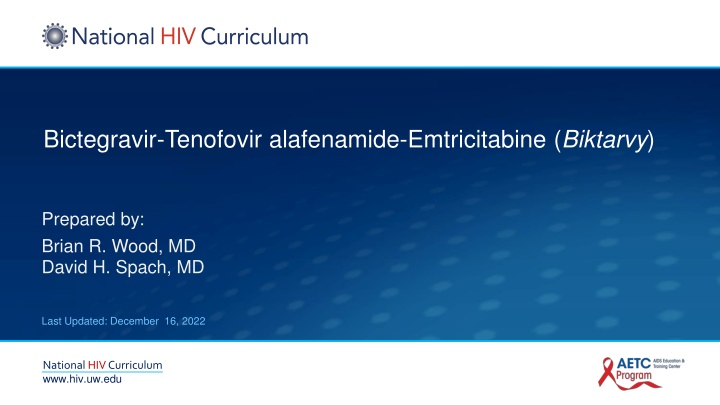
Bictegravir-Tenofovir-Alafenamide-Emtricitabine Overview
Explore the comprehensive guide on Bictegravir-Tenofovir-Alafenamide-Emtricitabine (Biktarvy) including dosages, side effects, drug interactions, study trials, and specific considerations for renal impairment and pregnancy. Stay informed about this important HIV medication and its impact on tubular secretion of creatinine.
Download Presentation

Please find below an Image/Link to download the presentation.
The content on the website is provided AS IS for your information and personal use only. It may not be sold, licensed, or shared on other websites without obtaining consent from the author. If you encounter any issues during the download, it is possible that the publisher has removed the file from their server.
You are allowed to download the files provided on this website for personal or commercial use, subject to the condition that they are used lawfully. All files are the property of their respective owners.
The content on the website is provided AS IS for your information and personal use only. It may not be sold, licensed, or shared on other websites without obtaining consent from the author.
E N D
Presentation Transcript
Bictegravir-Tenofovir alafenamide-Emtricitabine (Biktarvy) Prepared by: Brian R. Wood, MD David H. Spach, MD Last Updated: December 16, 2022 National HIVCurriculum www.hiv.uw.edu
Bictegravir-Tenofovir alafenamide-Emtricitabine Bictegravir-Tenofovir alafenamide-Emtricitabine 50 mg 25 mg 200 mg INSTI NRTI NRTI Dose: 1 tablet once daily with or without food
Bictegravir-Tenofovir alafenamide-Emtricitabine With Renal Impairment: do not initiate if estimated CrCl <30 mL/min Pregnancy: insufficient data Common Adverse Events ( 5%) - Diarrhea (6%) - Nausea (5%) - Headache (5%) Drug-Drug Interactions - Avoid: rifamycins, dofetilide, carbamazepine, phenytoin, St. John s wort - Consider: metformin, cation-containing compounds Source: Bictegravir-Tenofovir alafenamide-Emtricitabine. Prescribing Information.
Bictegravir and Inhibition of Tubular Secretion of Creatinine Peritubular capillary Tubular Secretion Proximal Tubule Multidrug and Toxin Extrusion Protein (MATE2) Organic Cation Transporter 2 (OCT2) Bictegravir Bictegravir Decreases tubular secretion of creatinine via inhibition of MAET1 andOCT2 Excretion Illustration: David H. Spach, MD
Bictegravir-Tenofovir alafenamide-Emtricitabine Summary of Key Phase 3 Studies Trials in in Treatment-Na ve Adults GS-380-1489: BIC-TAF-FTC vs. DTG-ABC-3TC GS-380-1490: BIC-TAF-FTC vs. DTG + TAF-FTC Trials in Adults with Virologic Suppression GS-380-1844: Switch to BIC-TAF-FTC vs. continue DTG-ABC-3TC GS-380-1878: Switch to BIC-TAF-FTC vs. continue boosted PI + NRTIs GS-380-1961: Switch to BIC-TAF-FTC for women GS-380-4030: Switch to BIC-TAF-FTC vs. DTG + TAF-FTC BAAVE2020: Switch to BIC-TAF-FTC for Black Americans Abbreviations: BIC-TAF-FTC = bictegravir-tenofovir alafenamide-emtricitabine; DTG-ABC-3TC =dolutegravir-abacavir-lamivudine; PI = protease inhibitor; NRTIs = nucleoside reverse transcriptase inhibitors
Bictegravir-Tenofovir alafenamide-Emtricitabine Trials in Treatment Treatment-Na ve Adults
BIC-TAF-FTC vs. DTG-ABC-3TC as Initial Therapy GS-380-1489: Week 48 Results
Bictegravir-TAF-FTC versus Dolutegravir-ABC-3TC as Initial Therapy GS-380-1489: Design Design - Randomized, double-blind, active-controlled, phase 3 study evaluating the efficacy and safety of bictegravir-tenofovir alafenamide-emtricitabine versus dolutegravir-abacavir-lamivudine for treatment-na ve adults with HIV Bictegravir-TAF-FTC (n = 314) Including Criteria - Age 18 years - Antiretroviral-na ve (or 10 days of treatment) - HIV RNA 500 copies/mL - eGFR 50 mL/min - HLA B*5701 negative - No chronic HBV infection Dolutegravir-ABC-3TC (n = 315) Source: Gallant J, et al. Lancet. 2017;390:2063-72.
Bictegravir-TAF-FTC versus Dolutegravir-ABC-3TC as Initial Therapy GS-380-1489: Week 48 Results Week 48 Virologic Response (Intention-to-Treat Analysis) Bictegravir-TAF-FTC Dolutegravir-ABC-3TC 100 HIV RNA <50 copies/mL (%) 93.0 92.4 80 60 40 20 290/314 293/315 0 No treatment-emergent resistance to any study drug occurred Source: Gallant J, et al. Lancet. 2017;390:2063-72.
Bictegravir-TAF-FTC versus Dolutegravir-ABC-3TC as Initial Therapy GS-380-1489: Adverse Effects Treatment Emergent Adverse Events (AE s >5%) Through Week 48 BIC-TAF-FTC (n = 314) DTG-ABC-3TC (n = 315) Adverse Effect Diarrhea, % 13 13 Headache, % 11 14 Nausea, % 10 23 Fatigue, % 6 9 Arthralgia, % 4 6 Insomnia, % 4 6 Change in eGFR (mL/min) -10.5 -10.8 Source: Gallant J, et al. Lancet. 2017;390:2063-72.
Bictegravir-TAF-FTC versus Dolutegravir-ABC-3TC as Initial Therapy GS-380-1489: Adverse Effects Change in Markers of Proximal Tubulopathy at 48 Weeks Bictegravir-TAF-FTC Dolutegravir-ABC-3TC 30 Median % Change from Baseline 19.9 20 13.6 6.2 10 0.6 0 -10 -20 -18.1 -23.0 -30 Urine Albumin/ Creatinine Retinonl Binding Protein Beta-2-Microglobulin/ Creatinine Source: Gallant J, et al. Lancet. 2017;390:2063-72.
Bictegravir-TAF-FTC versus Dolutegravir-ABC-3TC as Initial Therapy GS-380-1489: Adverse Effects Change in Bone Mineral Density at 48 Weeks Bictegravir-TAF-FTC Dolutegravir-ABC-3TC 0.5 Median % Change from Baseline 0.0 -0.5 -0.60 -0.78 -0.83 -1.0 -1.02 -1.5 Spine Hip Source: Gallant J, et al. Lancet. 2017;390:2063-72.
Bictegravir-TAF-FTC versus Dolutegravir-ABC-3TC as Initial Therapy GS-380-1489: Results Change in Lipids at 48 Weeks Bictegravir-TAF-FTC Dolutegravir-ABC-3TC 20 Median Change (mg/dL) 15 13 11 9 10 7 5 5 4 5 3 0 TC LDL HDL TG Source: Gallant J, et al. Lancet. 2017;390:2063-72.
Bictegravir-TAF-FTC versus Dolutegravir-ABC-3TC as Initial Therapy GS-380-1489: Conclusions Interpretation: At 48 weeks, coformulated bictegravir, emtricitabine, and tenofovir alafenamide achieved virological suppression in 92% of previously untreated adults and was non-inferior to coformulated dolutegravir, abacavir, and lamivudine, with no treatment- emergent resistance. Bictegravir, emtricitabine, and tenofovir alafenamide was safe and well tolerated with better gastrointestinal tolerability than dolutegravir, abacavir, and lamivudine. Because coformulated bictegravir, emtricitabine, and tenofovir alafenamide does not require HLA B*5701 testing and provides guideline-recommended treatment for individuals co-infected with HIV and hepatitis B, this regimen might lend itself to rapid or same-day initiation of therapy in the clinical setting. Source: Gallant J, et al. Lancet. 2017;390:2063-72.
BIC-TAF-FTC versus DTG + TAF-FTC as Initial Therapy GS-380-1490: Week 48 Results
Bictegravir-TAF-FTC versus Dolutegravir + TAF-FTC as Initial Therapy GS-380-1490: Design Design - Randomized, double-blind, active-controlled, phase 3 study comparing bictegravir-tenofovir alafenamide-emtricitabine versus dolutegravir plus tenofovir alafenamide-emtricitabine as initial therapy Bictegravir-TAF-FTC (n = 320) Inclusion Criteria - Age 18 years - Antiretroviral-na ve (or 10 days of treatment) - HIV RNA 500 copies/mL - eGFR 30 mL/min Dolutegravir + TAF-FTC (n = 325) Source: Sax PE, et al. Lancet. 2017;390:2073-82.
Bictegravir-TAF-FTC versus Dolutegravir + TAF-FTC as Initial Therapy GS-380-1490: Week 48 Results Week 48 Virologic Response (Intention-to-Treat Analysis) Bictegravir-TAF-FTC Dolutegravir + TAF-FTC 100 HIV RNA <50 copies/mL (%) 93 89 80 60 40 20 286/320 302/325 0 No participant discontinued due to lack of efficacy in either arm No treatment-emergent resistance to any study drug occurred Source: Sax PE, et al. Lancet. 2017;390:2073-82.
Bictegravir-TAF-FTC versus Dolutegravir + TAF-FTC as Initial Therapy GS-380-1490: Adverse Events Treatment Emergent Adverse Events (AE s >5%) Through Week 48 BIC-TAF-FTC (n = 320) DTG + TAF-FTC (n = 325) Headache, % 13 12 Diarrhea, % 12 12 Nausea, % 8 9 Fatigue, % 6 8 Arthralgia, % 5 3 Insomnia, % 5 4 Change in eGFR -7.3 mL/min -10.8 mL/min Abbreviations: eGFR = estimated glomerular filtration Source: Sax PE, et al. Lancet. 2017;390:2073-82.
Bictegravir-TAF-FTC versus Dolutegravir + TAF-FTC as Initial Therapy GS-380-1490: Conclusion Interpretation: These week 96 data support bictegravir, emtricitabine, and tenofovir alafenamide as a safe, well tolerated, and durable treatment for people living with chronic HIV. Source: Sax PE, et al. Lancet. 2017;390:2073-82.
BIC-TAF-FTC versus DTG + 2 NRTIs as Initial Therapy GS-380-1489 & 1490: Week 144 Results
Bictegravir-TAF-FTC versus Dolutegravir + TAF-FTC as Initial Therapy GS-380-1489 & 1490: Week 144 Results Week 144 Virologic Response (Intention-to-Treat Analysis) Bictegravir-TAF-FTC Dolutegravir + 2 NRTIs 100 HIV RNA <50 copies/mL (%) 80 84 84 82 81 60 40 20 262/320 273/325 265/315 256/314 0 Study 1489 Study 1490 No treatment-emergent resistance to any study drug occurred Source: Orkin C et al. Lancet HIV. 2020;7:e389-e400.
Bictegravir-TAF-FTC versus Dolutegravir + TAF-FTC as Initial Therapy GS-380-1489 & 1490 (Week 144): Results Week 144 Change in Weight from Baseline Bictegravir-TAF-FTC Dolutegravir + 2 NRTIs 10 Median Change from Baseline (kg) 8 6 5.0 4 4 3.5 4 2 0 Study 14989 Study 1490 Source: Orkin C et al. Lancet HIV. 2020;7:e389-e400.
Bictegravir-TAF-FTC versus Dolutegravir + TAF-FTC as Initial Therapy GS-380-1489 & 1490 (Week 144): Conclusion Interpretation: These long-term data support the use of bictegravir, emtricitabine, and tenofovir alafenamide as a safe, well tolerated, and durable treatment for people with HIV, with no emergent resistance. Source: Orkin C et al. Lancet HIV. 2020;7:e389-e400.
Bictegravir-Tenofovir alafenamide-Emtricitabine Switch Studies in Adults with Virologic Suppression
Switch from DTG-ABC-3TC to BIC-TAF-FTC in Adults with Virologic Suppression GS-380-1844
Switch from DTG-ABC-3TC to BIC-TAF-FTC GS-380-1844: Design Background: Randomized, phase 3, multicenter, double- blind, active-controlled study evaluating the efficacy and safety of switching adults with HIV and viral suppression to BIC-TAF-FTC versus continuing DTG-ABC-3TC Switch Regimen Bictegravir-TAF-FTC (n = 282) Inclusion Criteria - Age 18 years - HIV RNA <50 copies/mL for at least 3 months - eGFR 50 mL/min for at least 3 months - No history of treatment failure - Taking DTG-ABC-3TC or DTG + ABC-3TC - No documented or suspected resistance to DTG, ABC, 3TC, FTC, or TAF - HCV infection allowed - HBV infection not allowed Maintain Regimen Dolutegravir + ABC-3TC (n = 281) Source: Molina JM, et al. Lancet HIV. 2018;5:e357-e365.
Switch from DTG-ABC-3TC to BIC-TAF-FTC GS-380-1844: Results Week 48 Virologic Response (Intention-to-Treat Analysis) Bictegravir-TAF-FTC Dolutegravir-ABC-3TC 100 HIV RNA <50 copies/mL (%) 95.0 93.6 80 60 40 20 264/282 267/281 0 At 48 weeks, proportion with HIV RNA 50 copies/mL not statistically different: 1% BIC vs <1% DTG 5 participants met criteria for virologic failure and resistance testing (3 BIC, 2 DTG); no resistance found Source: Molina JM, et al. Lancet HIV. 2018;5:e357-e365.
Switch from DTG-ABC-3TC to BIC-TAF-FTC GS-380-1844: Results Most Common Treatment-Related Adverse Events (AE s) by 48 Weeks BIC-TAF-FTC (n = 282) DTG-ABC-3TC (n = 281) Baseline Antiretroviral Medications 2 1 AE s leading to study drug discontinuation Headache, % 2 3 Diarrhea, % 1 1 Abnormal dreams, % <1 2 Fatigue, % <1 1 Nausea, % 0 2 Insomnia, % 0 3 Source: Molina JM, et al. Lancet HIV. 2018;5:e357-e365.
Switch from DTG-ABC-3TC to BIC-TAF-FTC GS-380-1844: Conclusions Interpretation: The fixed-dose combination of bictegravir, emtricitabine, and tenofovir alafenamide might provide a safe and efficacious option for ongoing treatment of HIV-1 infection. Source: Molina JM, et al. Lancet HIV. 2018;5:e357-e365.
Switch from Boosted PI + 2 NRTIs to BIC-TAF-FTC with Viral Suppression GS-380-1878
Switch from Boosted PI + 2 NRTIs to Bictegravir-TAF-FTC GS-380-1878: Design Background - Randomized, phase 3, multicenter, open-label switch study evaluating the efficacy and safety of switching adults with viral suppression taking a boosted PI plus 2 NRTIs to BIC-TAF-FTC Switch Regimen Bictegravir-TAF-FTC (n = 290) Inclusion Criteria - Age 18 years - HIV RNA <50 copies/mL for 6 months - Taking stable antiretroviral regimen for 6 months - No history of virologic failure - No prior treatment with an INSTI - eGFR 50 mL/min - HBV and HCV allowed - Taking atazanavir or darunavir (each boosted by ritonavir or cobicistat) + TDF-FTC or ABC-3TC Maintain Regimen Boosted PI + 2 NRTIs (n = 287) Source: Daar E, et al. Lancet HIV. 2018;5:e347-e356.
Switch from Boosted PI + 2 NRTIs to Bictegravir-TAF-FTC GS-380-1878: Baseline Characteristics Study GS-380-1878 Baseline Characteristics BIC-TAF-FTC (n = 290) 48 Boosted PI + 2 NRTIs (n = 287) 47 Characteristic Median age, years (range) 84 82 Male, % 27 25 Black or African descent, % 21 16 Hispanic/Latino, % 617 626 Median CD4, cells/mL 8 6 HBV coinfection, % 5 5 HCV coinfection, % 107 105 Median eGFR, mL/min 84, 16 85, 15 Baseline TDF-FTC, ABC-3TC, % 57, 43 54, 46 Baseline DRV, ATV, % Source: Daar E, et al. Lancet HIV. 2018;5:e347-e356.
Switch from Boosted PI + 2 NRTIs to Bictegravir-TAF-FTC GS-380-1878: Baseline Characteristics Study GS-380-1878 Baseline Antiretroviral Regimen BIC-TAF-FTC (n = 290) Boosted PI + 2 NRTIs (n = 287) Baseline Antiretroviral Medications NRTI Tenofovir DF-emtricitabine, % 84 85 Abacavir-lamivudine, % 16 15 21 16 Protease Inhibitor Darunavir, % 57 54 Atazanavir, % 43 46 Source: Daar E, et al. Lancet HIV. 2018;5:e347-e356.
Switch from Boosted PI + 2 NRTIs to Bictegravir-TAF-FTC GS-380-1878: Results Week 48 Virologic Response (Intention-to-Treat Analysis) Bictegravir-TAF-FTC Boosted PI + 2 NRTIs 100 HIV RNA <50 copies/mL (%) 92 89 80 60 40 20 267/290 255/287 0 Primary outcome of HIV RNA 50 copies/mL at 48 weeks: 2% each arm Source: Daar E, et al. Lancet HIV. 2018;5:e347-e356.
Switch from Boosted PI + 2 NRTIs to Bictegravir-TAF-FTC GS-380-1878: Adverse Events Most Common Treatment-Related Adverse Events (AE s) Through 48 Weeks BIC-TAF-FTC (n = 290) Boosted PI + 2 NRTI s (n = 287) Headache, % 12 4 Diarrhea, % 8 8 Nasopharyngitis, % 7 12 URI, % 7 8 Back pain, % 5 6 Arthralgia, % 4 5 Change in eGFR -4.3 mL/min 0.2 mL/min Abbreviations: eGFR = estimated glomerular filtration Source: Daar E, et al. Lancet HIV. 2018;5:e347-e356.
Switch from Boosted PI + 2 NRTIs to Bictegravir-TAF-FTC GS-380-1878: Results Change in Lipids at 48 Weeks Bictegravir-TAF-FTC Boosted PI + 2 NRTI's 8 Median Change from Baseline (mg/dL) 5 6 4 3 3 4 1 1 2 0 0 -2 -4 -6 -6 -8 Total Cholesterol LDL HDL Triglycerides Source: Daar E, et al. Lancet HIV. 2018;5:e347-e356.
Switch from Boosted PI + 2 NRTIs to Bictegravir-TAF-FTC GS-380-1878: Conclusions Interpretation: Fixed-dose bictegravir, emtricitabine, and tenofovir alafenamide might be a safe and efficacious alternative to continued boosted protease inhibitor therapy in adults with HIV-1 infection. Source: Daar E, et al. Lancet HIV. 2018;5:e347-e356.
Switch to BIC-TAF-FTC in Women with Virologic Suppression GS-380-1961
Switch to BIC-TAF-FTC in Women with Virologic Suppression GS-380-1961: Design Background: Randomized, phase 3, multicenter, open label, active-controlled study evaluating the efficacy and safety of switching women with HIV and viral suppression to BIC-TAF-FTC versus continuing their baseline regimen Switch Regimen Bictegravir-TAF-FTC (n = 234) Inclusion Criteria - Women aged 18 years - HIV RNA <50 copies/mL for at least 12 weeks - *EVG/c/TAF/FTC, EVG/c/TDF/FTC, or ATV/r + TDF/FTC - eGFR >50 mL/min - No suspected resistance to study drugs - Using contraception if child-bearing potential - Chronic hepatitis B or C allowed Maintain Regimen INSTI or PI-Based Regimen (n = 236) *Regimens: 53% EVG/c/TAF/FTC and 42% EVG/c/TDF/FTC Source: Kityo C, et al. J Acquir Immune Defic Syndr. 2019;82:321-8.
Switch to BIC-TAF-FTC in Women with Virologic Suppression GS-380-1961: Results by U.S. FDA Snapshot Algorithm Bictegravir-TAF-FTC Maintain Regimen 100 95.7 95.3 HIV RNA <50 copies/mL (%) 80 60 40 20 224/234 225/236 0 Source: Kityo C, et al. J Acquir Immune Defic Syndr. 2019;82:321-8.
Switch to BIC-TAF-FTC in Women with Virologic Suppression GS-380-1961: Conclusions Interpretation: Fixed-dose combination bictegravir-emtricitabine-tenofovir alafenamide provides a safe and efficacious option for ongoing treatment of HIV in women. This study contributes important data on safety, tolerability, and outcomes of antiretroviral therapy among women living with HIV. Source: Kityo C, et al. J Acquir Immune Defic Syndr. 2019;82:321-8.
Switch to BIC-TAF-FTC or DTG + TAF-FTC in Adults with Virologic Suppression GS-380-4030
Switch to BIC-TAF-FTC or DTG + TAF-FTC in Adults with Virologic Suppression GS-380-4030: Design Background - Randomized, double-blind, switch study comparing the efficacy of switching adults with viral suppression (with or without documented or suspected NRTI resistance) taking DTG plus TAF-FTC or TDF-FTC to BIC-TAF-FTC versus DTG plus TAF-FTC Bictegravir-TAF-FTC (n = 284) Inclusion Criteria - Age 18 years - HIV RNA <50 copies/mL for 3 months if no resistance - HIV RNA <50 copies/mL for 6 months if NRTI resistance - Taking stable regimen of DTG plus TDF-FTC or TAF-FTC - eGFR 30 mL/min - Chronic HBV and HCV infection permitted - Documented or suspected NRTI resistance permitted - Excluded if integrase resistance or virologic failure on INSTI Dolutegravir + TAF-FTC (n = 281) Source: Sax PE, et al. Clin Infect Dis. 2021;73:e485-e493.
Switch to BIC-TAF-FTC or DTG + TAF-FTC in Adults with Virologic Suppression GS-380-4030: Baseline Characteristics Study GS-380-4030 Baseline Participant Demographics & Clinical Characteristics BIC-TAF-FTC (n = 284) DTG + TAF-FTC (n = 281) Baseline Characteristic Age, years, median (range) 51 (22-79) 50 (20-79) Women, n (%) 39 (14%) 41 (15%) Black, n (%) 68 (24%) 61 (22%) Hispanic or Latino, n (%) 61 (22%) 49 (18%) CD4 cell count, cells/ L, median (IQR) 659 (486-885) 642 (462-791) TAF-FTC NRTI backbone, n (%) 194 (68%) 195 (69%) 16 (6%) 14 (5%) K65R/E/N or 3 TAMs mutation(s), n (%) Any other pattern of NRTI mutation(s), n (%) 55 (19%) 53 (19%) No NRTI mutation, n (%) 213 (75%) 214 (76%) Source: Sax PE, et al. Clin Infect Dis. 2021;73:e485-e493.
Switch to BIC-TAF-FTC or DTG + TAF-FTC in Adults with Virologic Suppression GS-380-4030: Results Virologic Outcome at Week 48 Bictegravir-TAF-FTC Dolutegravir + TAF-FTC 100 HIV RNA <50 copies/mL (%) 93.3 91.1 80 60 40 20 0 265/284 256/281 Primary outcome of HIV RNA 50 copies/mL at 48 weeks: 0.4% BIC-TAF-FTC arm; 1.1% DTG + TAF-FTC arm Source: Sax PE, et al. Clin Infect Dis. 2021;73:e485-e493.
Switch to BIC-TAF-FTC or DTG + TAF-FTC in Adults with Virologic Suppression GS-380-4030: Conclusions Interpretation: The single-tablet regimen B/F/TAF is a safe, effective option for people virologically suppressed on DTG plus either F/TDF or F/TAF, including in individuals with preexisting resistance to NRTIs. Source: Sax PE, et al. Clin Infect Dis. 2021;73:e485-e493.
Switch to Bictegravir-Tenofovir alafenamide-Emtricitabine for Black Americans BRAAVE2020
Switch to Bictegravir-TAF-FTC for Black Americans BRAAVE2020: Design Background - Randomized, phase 3, multicenter, open-label switch study evaluating the efficacy and safety of switching Black American adults with viral suppression to BIC- TAF-FTC, including individuals with a history of NRTI, NNRTI, and/or PI resistance Switch Regimen Bictegravir-TAF-FTC (n = 328) 2x Inclusion Criteria - Age 18 years - Self-described as Black, African American, or mixed race that includes Black - HIV RNA <50 copies/mL for 12 months - Taking stable antiretroviral regimen that includes 2 NRTIs plus 3rdagent for 6 months - eGFR 50 mL/min - No INSTI resistance; no K65R, T69ins, or 3TAMs 1x Maintain Regimen Continue baseline ART (n = 165) 10% of all participants with M184V at baseline Source: Hagins D, et al. JAIDS. 2021;88:86-95.
Switch to Bictegravir-TAF-FTC for Black Americans BRAAVE2020: Baseline Characteristics BRAAVE2020 Baseline Participant Demographics & Clinical Characteristics BIC-TAF-FTC (n = 328) Continue Baseline ART (n = 165) Baseline Characteristic Age, years, median (range) 49 (18-79) 49 (19-70) Female sex at birth, n (%) 101 (31) 55 (33) Cisgender, n (%) 317 (96) 159 (96) Hispanic or Latino, n (%) 61 (22%) 49 (18%) CD4 cell count, cells/ L, median (IQR) 747 (570-922) 758 (494-969) TAF-FTC NRTI backbone, n (%) 224 (68) 107 (65) TDF-FTC NRTI backbone, n (%) 56 (17) 34 (21) ABC-3TC NRTI backbone, n (%) 44 (13) 24 (15) Other NRTI backbone, n (%) 4 (1) 0 Source: Hagins D et al. JAIDS. 2021;88:86-95.
Switch to Bictegravir-TAF-FTC for Black Americans BRAAVE2020: Baseline Characteristics BRAAVE2020 Baseline Participant Demographics & Clinical Characteristics BIC-TAF-FTC (n = 328) Continue Baseline ART (n = 165) Baseline Characteristic Baseline 3rd agent, n (%) INSTI NNRTI PI CCR5 antagonist Baseline ARV resistance, n (%) NRTI resistance M184V/I NNRTI resistance PI resistance INSTI resistance 202 (61) 100 (30) 30 (9) 0 99 (60) 51 (31) 14 (9) 1 (1) 44 (13) 31 (9) 70 (21) 36 (11) 8 (2) 26 (16) 20 (12) 32 (19) 26 (16) 3(2) Source: Hagins D et al. JAIDS. 2021;88:86-95.




